Special Report: Darwin 1000
calcium supplement for many kinds of cropsDarwin 1000
Special fertilizer (gypsum)
Shape: Particle with particle size of 5 mm or less Packaging: Plastic bag 20 kg / bag or flexible container 500 kg / container
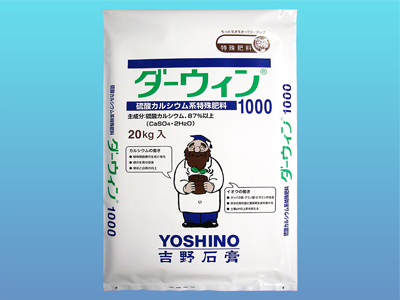
- This product will affect the ph of the soil.
- Calcium sulfate, the main ingredient, dissolves well in water and is efficiently absorbed by crops.
- Through the synergistic effect of calcium and sulfur, soil quality will be recovered, the crop will grow healthily, and it will be effective in improving quality and yield.
- Helping root growth
- Healthy growth with cellular strengthening of crop plants ⇒ Yield increase
- Improved freshness and storability
Reducing symptoms caused by calcium deficiency
- Tomatoes and green peppers (reducing bell rot)
- Cabbage and lettuce (reducing core rot, peripheral rot)
- Radishes, turnip (reducing red core symptom)
- Cucumber (reducing brown core rot)
- Potato (reducing brown core rot, producing smooth surface)
- Broccoli (reducing flower bud rot)
Freshness preservation with mineral supplement
- Edamame (green soybeans), white onion
Reducing collapse
- Sweet corn
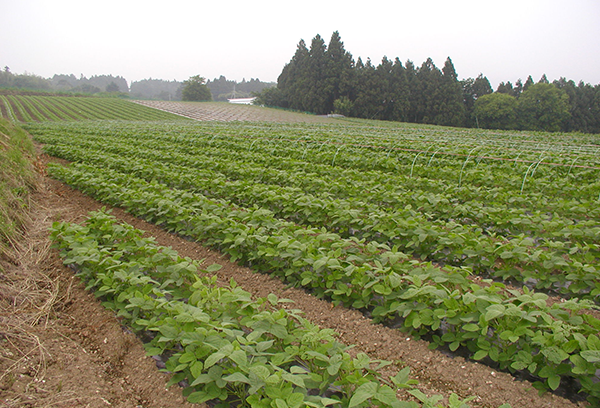
Edamame (green soybeans)
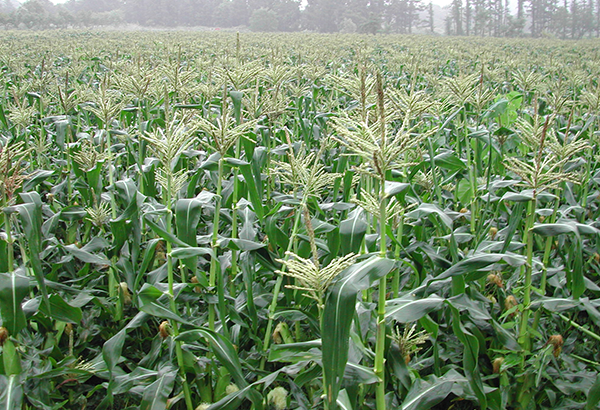
Sweet corn
- Nurturing of coloration in many kinds of fruit
- Grapes. Particularly large fruit (raising product quality by decreasing fallen fruit)
- Apple (raising product quality by protecting the surface)
- Pear (reducing fallen fruit and mitosis)
- Cherry (reducing light saltiness of the fruit)
- Chrysanthemum, lilies (preventing leaf frost)
- Nurturing root growth and improving quality of crop (base fertilizer)
- Reducing collapse and improving ripening grade (fertilizer application in the middle of period)
Farmer’s voice
Shiono Shoten (Tone Numata district, Gunma prefecture): Currently using this product for growing “Tengu Brand” edamame
Shiono Shoten is managing the entire process from production to sales of “Tengu Brand Edamame”
cultivated and shipped by the Numata Tone Vegetable Marketing Cooperative (around 200 farmers).
"Our shop regularly conducts soil analysis for each field, and we are providing guidance for using Darwin fertilizer
as a mineral supplement material. As part of our quality assurance, we confirm that it has positive effect on our freshness management. "
Konbe Farm (Mt. Iwakisan foothills, Hirosaki city, Aomori prefecture): Currently using this product for growing “Dakekimi” sweet corn
Konbe is one of the farmers raising “Dakekimi” sweet corn with integrated production, from cultivation to sales.
"In the foothills of Mt. Iwate in Aomori prefecture, spring comes late, and sowing begins in May. So, “Datekimi” harvest season begins in mid August. We hope that Darwin is able to reduce crop collapse caused by the typhoon in the second half of the harvest season and maintain freshness, so we are using as the base fertilizer. "
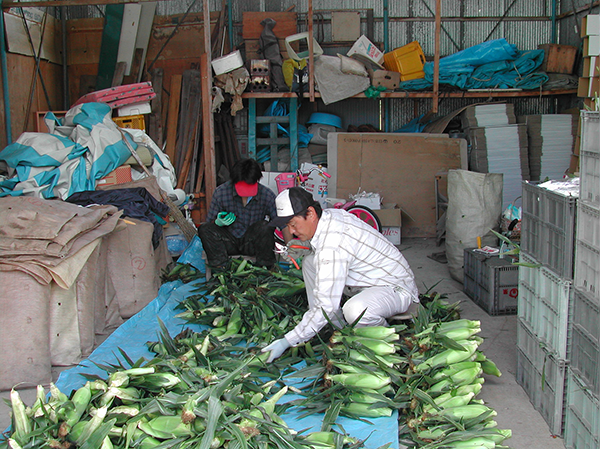
Hosono Pear Farm (Tomisato city, Chiba prefecture): Currently using this product for growing pears.
Hosono is certified by the Chiba prefectural government as having “Chiba Eco-agricultural Product Certification”, and manages the combined farm of vegetables and fruit trees. Fruit tree sales are focused on direct sales.
"Reduction of fallen fruit trees during harvest time and mitigation effect of mitosis are linked to yield increase."
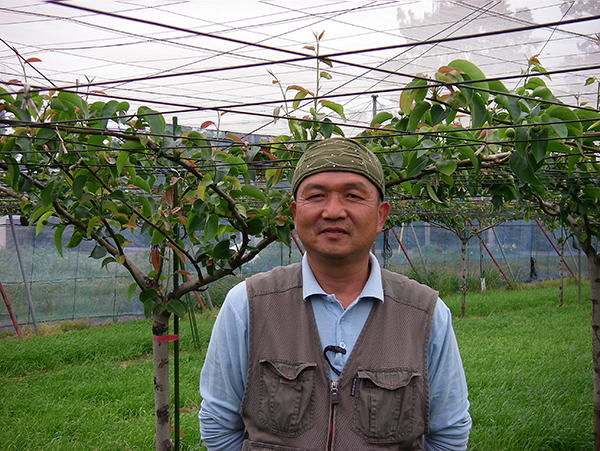
※Some farmers also use foliar spray agent (FC 100)
-
Comparison of harvest volume

Left: Darwin Right: Traditional
-
Skin comparison
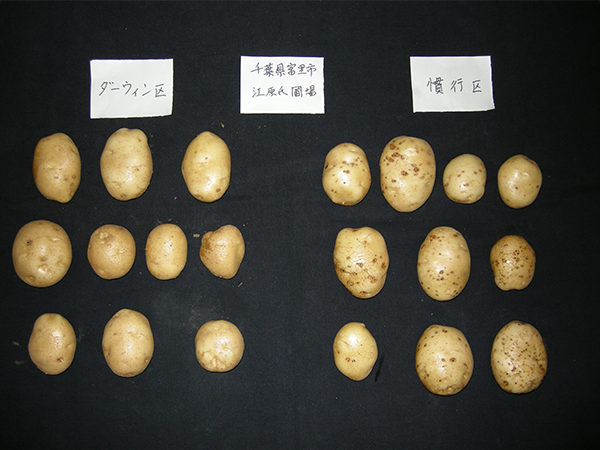
Left: Darwin Right: Traditional
Rules for using Darwin1000
| Crop | Application method | Usage period | Amount used per 10a | |
|---|---|---|---|---|
| Vegetables | Full-scale mixture Applying fertilizer to the side row |
During base fertilizing | 3~5 bags | |
| During supplementary fertilizing | 2~3 bags | |||
| Fruit tree | Full-scale dispersion | After-season fertilizing Or during base fertilizing (autumn fertilizing) |
2~3 bags | |
| Paddy rice | Full-scale mixture Applying fertilizer to the side row |
During seedling stage | Floor soil 100g per m 2 | |
| During base fertilizing | 2~3 bags | |||
| During supplementary fertilizing | During regulative fertilizing | 1~2 bags | ||
| During fertilization for head-sprouting | 1~2 bags | |||
| Grass pasture | Full-scale mixture | During base fertilizing | 3~4 bags | |
| During supplementary fertilizing | 1~2 bags | |||
| Flowers | Full-scale mixture Applying fertilizer to the side row |
During base fertilizing | 3~4 bags | |
| During supplementary fertilizing | 1~2 bags | |||
※Application method may vary depending on the type of crop. For details, please contact us or our distributors.
※Side row fertilizer application should be around 70% of the whole surface spraying.
Analysis example
- Calcium(CaO)29%
- Sulfur(S)15.7%
- Total phosphoric acid(P2O5)0.4%
- Held water(H2O)0.5%
- pH5.5
Drawin 1000 application example
- Test sample:
- Potato
- Test location:
- Mr. E’s farm in Tomisato city, Chiba prefecture
- Planting density:
- Ridge spacing: 100cm, intrarow spacing: 30cm
- Survey method:
- Comparative survey between the yields of the whole area mixed with 80kg / 10a of Darwin 1000 (Darwin area) before planting in late February 2007, and the yield of traditional method.
- Survey result:
-
5 potatoes were taken from each area, measured three times and averaged
Area Weight of 5 potatoes (g) Weight of each potato (g) Weight of 10a yield (kg) Darwin 6,474 156.6±62.5 4,316.0 (105.7% compared to traditional method) Traditional 6,124 151.8±67.9 4,082.9 Survey date: June 26th, 2007- The average weight of one potato in Darwin area was heavier than in the traditional area, and the variation in weight decreased.
- Darwin area has increased yield by about 6% compared to the traditional area.
- Scab disease seems to be less likely to occur in Darwin area compared to the traditional area (photo).
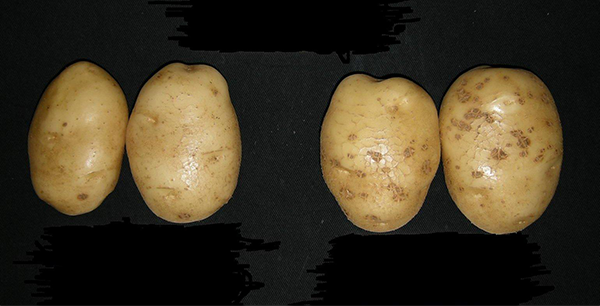
Comparison of scab disease occurrence in potatoes
(Left: Darwin Right: Traditional)
- Effects of fertilizer with gypsum as its main raw material
- Special Report: Darwin 1000
- Special Report: Darwin 2000
- Special Report: Darwin 5000
- Special Report: Darwin 5050
- Special Report: Darwin FC100
